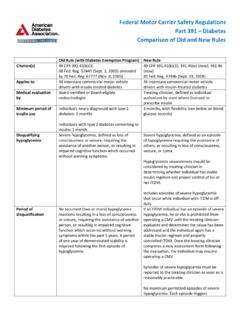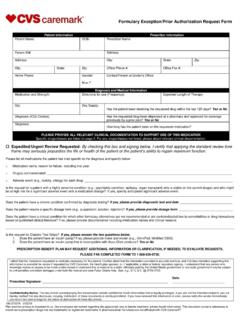Transcription of Use of Glycated Haemoglobin (HbA1c) in the Diagnosis of ...
1 WHO/NMH/CHP/ Use of Glycated Haemoglobin (HbA1c) in the Diagnosis of Diabetes Mellitus Abbreviated Report of a WHO Consultation 2 World Health Organization 2011 All rights reserved. Publications of the World Health Organization can be obtained from WHO Press, World Health Organization, 20 Avenue Appia, 1211 Geneva 27, Switzerland (tel.: +41 22 791 3264; fax: +41 22 791 4857; e-mail: Requests for permission to reproduce or translate WHO publications whether for sale or for noncommercial distribution should be addressed to WHO Press, at the above address (fax: +41 22 791 4806; e-mail: The designations employed and the presentation of the material in this publication do not imply the expression of any opinion whatsoever on the part of the World Health Organization concerning the legal status of any country, territory, city or area or of its authorities, or concerning the delimitation of its frontiers or boundaries.))
2 Dotted lines on maps represent approximate border lines for which there may not yet be full agreement. The mention of specific companies or of certain manufacturers products does not imply that they are endorsed or recommended by the World Health Organization in preference to others of a similar nature that are not mentioned. Errors and omissions excepted, the names of proprietary products are distinguished by initial capital letters. All reasonable precautions have been taken by the World Health Organization to verify the information contained in this publication. However, the published material is being distributed without warranty of any kind, either expressed or implied. The responsibility for the interpretation and use of the material lies with the reader.
3 In no event shall the World Health Organization be liable for damages arising from its use. 3 Executive Summary This report is an addendum to the diagnostic criteria published in the 2006 WHO/IDF report Definition and Diagnosis of diabetes mellitus and intermediate hyperglycaemia , and addresses the use of HbA1c in diagnosing diabetes mellitus. This report does not invalidate the 2006 recommendations on the use of plasma glucose measurements to diagnose diabetes. A WHO expert consultation was held from 28 to 30 March 2009 .. A systematic review was conducted on the use of HbA1c as a diagnostic test for diabetes mellitus.
4 The evidence was summarized and its quality evaluated using the GRADE methodology. The recommendation was formulated and its strength was rated on a two-point scale, based on the quality of evidence and the applicability and performance of the method in different settings. The WHO Consultation concluded that HbA1c can be used as a diagnostic test for diabetes, provided that stringent quality assurance tests are in place and assays are standardised to criteria aligned to the international reference values, and there are no conditions present which preclude its accurate measurement. An HbA1c of is recommended as the cut point for diagnosing diabetes. A value less than does not exclude diabetes diagnosed using glucose tests. The expert group concluded that there is currently insufficient evidence to make any formal recommendation on the interpretation of HbA1c levels below GRADE quality of evidence: moderate GRADE strength of recommendation: conditional 4 1.
5 INTRODUCTION The term diabetes mellitus describes a metabolic disorder with heterogenous aetiologies which is characterized by chronic hyperglycaemia and disturbances of carbohydrate, fat and protein metabolism resulting from defects in insulin secretion, insulin action, or both (1). The long term relatively specific effects of diabetes include development of retinopathy, nephropathy and neuropathy (2). People with diabetes are also at increased risk of cardiac, peripheral arterial and cerebrovascular disease (3). Diabetes and lesser forms of glucose intolerance, impaired glucose tolerance (IGT) and impaired fasting glucose (IFG), can now be found in almost every population in the world and epidemiological evidence suggests that, without effective prevention and control programmes, the burden of diabetes is likely to continue to increase globally (4;5).
6 Because diabetes is now affecting many in the workforce, it has a major and deleterious impact on both individual and national productivity. The socio-economic consequences of diabetes and its complications could have a seriously negative impact on the economies of developed and developing nations (6). It was against this background that on 20 December, 2006, the United Nations General Assembly unanimously passed Resolution 61/225 declaring diabetes an international public health issue and declaring World Diabetes Day as a United Nations Day. Background to current report WHO has published several guidelines for the Diagnosis of diabetes since 1965 (7-10). Both Diagnosis and classification were reviewed in 1999 and were published as the guidelines for the Definition, Diagnosis and Classification of Diabetes Mellitus(1).
7 The potential utility of HbA1c in diabetes care is first mentioned in the 1985 WHO report (9). As more information relevant to the Diagnosis of diabetes became available, WHO, with the IDF, convened a joint expert meeting in 2005 to review and update the recommendations on Diagnosis only(10). After consideration of the data available and the recommendations made at that time by other international and global organisations, the 2005 consultation made the following recommendations (10): 1. The previous (1999) WHO diagnostic criteria should not be changed. 2. The diagnostic cut-point for IFG ( mmol/l; 110 mg/dl) should not be changed. 3. HbA1c should not be adopted as a diagnostic test, as the challenges of measurement accuracy outweighed the convenience of its use.
8 5 The full document can be downloaded from the WHO website: In March 2009, WHO convened the present consultation in order to update the 1999 and 2006 reports with the place of HbA1c in diagnosing diabetes, based on available evidence. The update process The members of the consultation included experts in diabetology, biochemistry, immunology, genetics, epidemiology and public health (Annex 4). The main question to be answered for the update was agreed upon by the expert group: How does HbA1c perform in the Diagnosis of type 2 diabetes based on the detection and prediction of microvascular complications?
9 A search for existing systematic reviews in EMBASE and MEDLINE did not identify any relevant systematic review. Therefore, a systematic review to answer this question was conducted by the Boden Institute of Obesity, Nutrition and Exercise, The University of Sydney, Sydney, Australia. The recommendation was drafted by the expert group following the GRADE methodology(11) and the process outlined in the WHO Handbook for Guideline Development . The decision process took into account the findings of the systematic review and the advantages and disadvantages of using HbA1c to diagnose diabetes (Annex 3). The recommendation, quality of evidence and strength of the recommendation were discussed and consensus was reached. All the experts agreed on the recommendation.
10 The systematic review with GRADE tables is available at The strength of the recommendation was based on the quality of evidence and feasibility and resource implications for low and middle-income countries. The strength of the recommendation is rated on a two-point scale: Weak/conditional: low/moderate/high quality of evidence and/or not applicable at population level in low-resource settings; Strong: high/moderate quality of evidence and applicable at population level in low-resource settings. Diagnostic criteria based on plasma glucose values were reviewed in 2006 and were not revised in this update. The main question, systematic review and draft recommendation were reviewed by WHO Regional Advisers for noncommunicable diseases and by additional three external experts.














